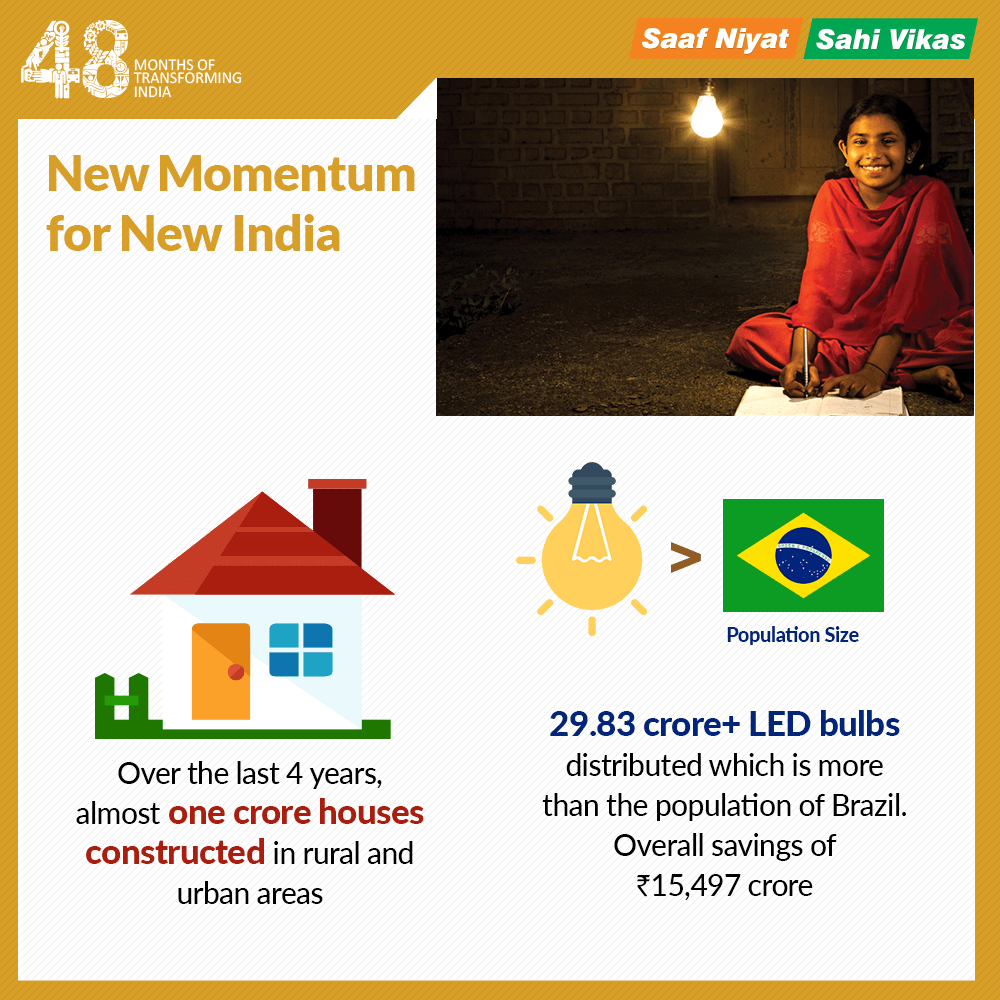[orc]The government published an infographic titled ‘New momentum for new India’ on the 48-months portal. It makes two claims regarding construction of houses and distribution of LED lights. The following article is a fact check of these claims.
The government published an infographic titled ‘New momentum for new India’ on the 48-months portal. It makes two claims regarding construction of houses and distribution of LED lights. The following article is a fact check of these claims.

How many houses have been built over the last four years?
The first claim is that over the last 4 years, almost one crore houses have been constructed in rural and urban India.
In response to a question in the Rajya Sabha, the government stated that, ‘To pursue the objective of ‘Housing for All by 2022’, the Government approved re- structuring of the erstwhile rural housing scheme Indira Awaas Yojana (IAY) into Pradhan Mantri Awaas Yojana -Gramin (PMAY-G). Under PMAY-G, the beneficiaries are to be selected from Socio Economic and Caste Census (SECC) 2011 list and as verified by the Gram Sabha will get enhanced unit assistance with additional assistance for toilet construction, unskilled wage labour under MGNREGS. Use of locally available construction material, increased availability of rural masons through rural mason training programme for better quality of construction, availability of house design choices etc. are other feature of PMAY-G. Under PMAY-G, it is proposed to construct one crore houses in three years from 2016-17 to 2018-19.’
In response to another question in the Rajya Sabha, the government stated a total of 94.91 lakh houses were built in the rural areas between 2015 and 2018 and 42.93 lakh houses were sanctioned to be built in urban areas during the same period. This makes the total of more than one crore houses. It has to be noted that even during the previous government, substantial number of houses were built in the rural areas.
Claim: Over the last 4 years, almost one crore houses have been constructed in rural and urban India.
Fact: 94.91 lakh houses were built in the rural areas between 2015 and 2018 and 42.93 lakh houses were sanctioned to be built in urban areas during the same period. Hence, the claim is TRUE.
How many LED bulbs have been distributed? What has been the saving from this?
The second claim is that more than 29.83 crore LED bulbs have been distributed which is more than the population of Brazil and that it resulted in an overall savings of Rs 15,496 crore.
According to an answer provided in Lok Sabha by the government, ‘Energy Efficiency Services Limited (EESL), a joint venture company of Public Sector Undertakings (PSUs) under the Ministry of Power, has launched Unnat Jyoti by Affordable LED for All (UJALA) Programme to provide LED bulbs to domestic consumers, with a target to replace 77 crore incandescent bulbs with LED bulbs by March 2019’.
As per the same answer, EESL has distributed over 28.16 crore LED bulbs covering all 36 States/UTs across the country by December 2017. According to the Ujala dashboard on 20th November 2018, the number of LED light bulbs distributed is 31.49 crores. This has amounted to a saving of 16,362 core rupees per year. The population of Brazil, in the year 2018 is 21.14 according to World Population Review.
The calculations on savings are based on the premise that these LED bulbs result in reduction of electricity consumption in excess of 10%. The study by an independent energy group ‘Prayas’ corroborates reduction in the electricity consumption because of the LED bulbs. At the same time, the study says, ‘A considerably large proportion of the UJALA LED bulbs were used to replace CFLs, followed by incandescent bulbs and tube lights. Although these observations are limited to the cities we surveyed, they differ substantially from the assumptions used by EESL to estimate the savings from the UJALA programme at the national level. EESL assumes that households are using all the LED bulbs bought through UJALA, that all of these bulbs were used to replace incandescent bulbs, and that all the bulbs are being used for about eight hours daily. A wider survey across different states can result in better assumptions and consequently a realistic estimation of actual savings realised.’ The study further recommends that EESL’s estimation of savings realised from UJALA needs to be justified by wider surveys collecting data on the actual use of LED Bulbs.
During the UPA government’s tenure, LED Village Campaign Scheme was implemented by the Bureau of Energy Efficiency (BEE) where villages are adopted for demonstration projects and LED bulbs are provided free of cost. But it was not as widespread as the current scheme and was only the beginning of promoting energy efficient lighting solutions.
Claim: More than 29.83 crore LED bulbs have been distributed which is more than the population of Brazil. Overall savings of 15,496 crore rupees.
Fact: 31.49 crore LED bulbs have been distributed till date while the population of Brazil is 21.14 crore. As per government figures, this has resulted in savings of 16,362 crore rupees per year. Since the amount of savings is not corroborated by any independent study, the claim is PARTLY TRUE.
This story is part of a larger series on the 4-years of the Modi government. This series has been made possible with the flash grant of the International Fact Checking Network (IFCN). Read the rest of the stories in this series here.


